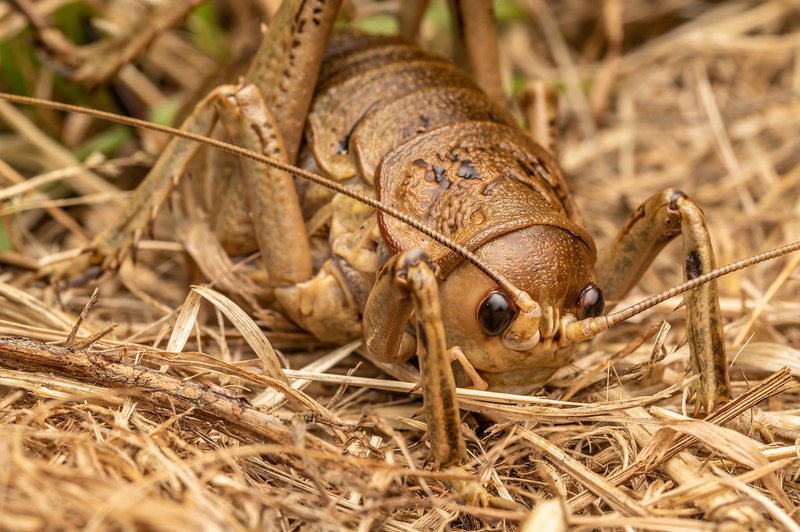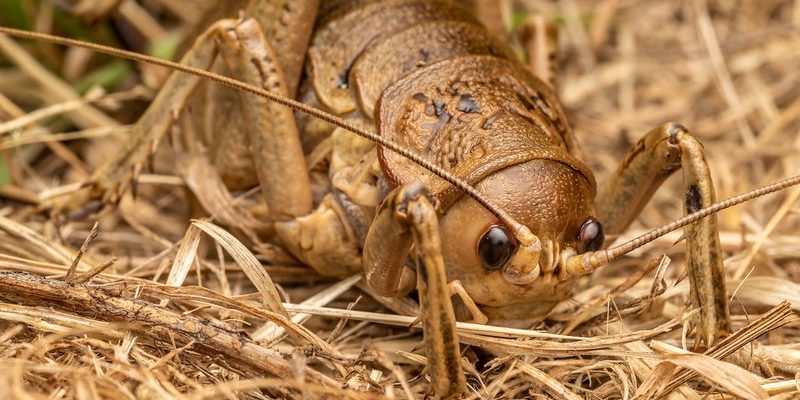
Imagine walking through a lush, green forest in New Zealand and stumbling upon an insect that looks like something out of a science fiction movie. Meet the Giant Weta, a hulking cricket relative that can weigh more than a small bird! These fascinating creatures are not just big; they’re also unique in behavior, habitat, and appearance. If you’ve ever been curious about these amazing insects, you’re in for a treat!
The Giant Weta isn’t just another bug; it’s a remarkable example of how diverse life can be on our planet. With its sizable body, impressive legs, and sometimes bizarre appearance, it captures the imagination of many. So, what makes this insect so special, and why should we pay attention to it? Let’s dive into the world of the Giant Weta, where we’ll explore everything from its diet to its role in the ecosystem!
Physical Characteristics of the Giant Weta
First and foremost, let’s talk about what sets the Giant Weta apart physically. These insects can grow to be about 4 inches long (that’s around 10 centimeters!) and some species can even reach up to 10 inches across when you include their long antennae. Imagine a creature that can weigh up to 71 grams—yes, some can weigh as much as a small kitten! It’s a sight that would leave anyone in awe.
What’s more intriguing is their appearance. The Giant Weta has a bulky body covered in a brown, textured exoskeleton that helps camouflage it against the forest floor. They have long, spindly legs that allow them to jump and move around with surprising agility for their size. Their large compound eyes give them excellent vision, which is essential for navigating their environment, especially at night when they are most active.
Another interesting aspect is their unique mating rituals, which involve males displaying their size and strength. This can include elaborate posturing to attract females. It’s a whole drama played out in the underbrush, showcasing their characteristics further!
Habitat and Distribution
The Giant Weta is native to New Zealand, particularly thriving in forested areas. Their preferred habitats are dense brush and woodland, where they can find plenty of food and protection. New Zealand’s unique ecosystem is shaped partly by these insects, as they play a crucial role in their environment by helping to decompose plant material.
Interestingly, while they enjoy the cool, humid conditions of the forest, some species of Giant Weta have adapted to live on small islands. These isolated populations can sometimes be found on offshore islands, such as Little Barrier Island. This adaptation has helped them thrive despite environmental changes and predators like rats.
Understanding their habitat is essential for conservation efforts. Since New Zealand has a history of losing native species due to habitat destruction and introduced predators, knowing where to find Giant Wetas helps protect them and their homes.
Diet and Eating Habits
What do you think a giant insect like the Weta eats? Well, you might be surprised to learn that they are largely herbivorous. The Giant Weta feeds mainly on leaves, flowers, and decaying plant matter. They have strong jaws, which they use to chew through tough plant material. It’s fascinating how they’ve adapted to a diet that allows them to thrive in their specific environments!
But they aren’t just picky eaters; they also serve a critical role in their ecosystem. By munching on decaying vegetation, these insects help to break down plant material, returning nutrients to the soil and promoting healthier plant growth. Think of them as nature’s recyclers, playing their part in a larger ecological picture.
One of the more interesting facts is their ability to fast for extended periods. This trait allows Giant Wetas to survive in times when food is scarce. During dry periods, they can conserve energy and wait for better times to come. It’s a strategy that showcases how resourceful these creatures can be!
Behavior and Lifespan
The Giant Weta leads a very intriguing life. These insects are primarily nocturnal, meaning they come out at night to feed and carry out their daily activities. During the day, you can often find them hiding under the foliage or in burrows to avoid predators. Their camouflage helps them blend into their surroundings, making them less susceptible to birds and other hunters looking for a meal.
They are not the most social creatures but often share their space with others of their kind. Their mating dances can be quite a spectacle, as males showcase their size to win over females. After mating, females lay their eggs in the ground, where they remain until they hatch—sometimes taking many months, depending on environmental conditions.
Speaking of lifespan, Giant Wetas have a surprisingly long life for insects. They can live for several years—up to 3 years in some cases! This lifespan, combined with their unique development cycle, makes them quite fascinating. They go through several molts before reaching adulthood, each stage an important step in their growth.
Conservation Status
Unfortunately, the Giant Weta faces challenges due to habitat loss and introduced species. As we discussed earlier, New Zealand has suffered from the impact of invasive species like rats and stoats, which prey on these insects. Conservation efforts are underway to protect the Giant Weta and their habitats.
Organizations are working to eradicate invasive predators from certain areas and re-establish populations of Giant Wetas on predator-free islands. These efforts are essential to preserve not just the Giant Weta but also the unique biodiversity of New Zealand’s ecosystems.
If you’re passionate about helping wildlife, supporting conservation programs can help ensure that future generations get to experience the awe of encountering a Giant Weta in its natural habitat. Every little bit helps in the fight for these remarkable creatures!
Interesting Facts about the Giant Weta
| Scientific Name: | Hemideina spp. |
| Size: | Up to 4 inches long |
| Weight: | Up to 71 grams |
| Diet: | Herbivorous, feeding on leaves and decaying plants |
| Lifespan: | Up to 3 years |
| Habitat: | Forests and islands in New Zealand |
Giant Weta in Culture and Folklore
Beyond their ecological role, Giant Wetas hold a place in New Zealand’s culture and folklore. They are often brought up in stories and myths, symbolizing resilience and adaptability. The Māori people, New Zealand’s indigenous inhabitants, have traditionally viewed these insects with a sense of intrigue and respect. Their unique features and behaviors have inspired tales, illustrating the interconnectedness of nature and culture.
Moreover, the Giant Weta has become something of a mascot for New Zealand’s unique wildlife. You might find images or references to them in art, tourism, and educational materials. This recognition helps raise awareness about the importance of preserving not only the Giant Weta but all species that contribute to the rich tapestry of New Zealand’s ecosystems.
This cultural significance further enhances our appreciation of these creatures. By understanding their role in stories and traditions, we can foster a deeper connection to the environment and the animals that call it home.
FAQ
What is the difference between Giant Wetas and other types of Wetas?
The main difference between Giant Wetas and other Wetas lies in their size and habitat. Giant Wetas are much larger, with some species known to weigh as much as a small kitten. Other Wetas, while still sizeable, tend to be smaller and can be found in different habitats across New Zealand. Behaviorally, Giant Wetas are more solitary, whereas smaller species might be more social.
Are Giant Wetas dangerous to humans?
Giant Wetas are not dangerous to humans. They are not aggressive and typically prefer to avoid confrontation. While they have strong jaws that can deliver a bite if threatened, they are more likely to flee than fight. Their role is primarily as decomposers, and they pose no threat to our safety.
How do Giant Wetas communicate?
Giant Wetas communicate primarily through physical displays. Males often engage in postures to attract females, showcasing their size and strength. They may also use subtle movements and sounds during mating rituals. However, they are not known for complex vocalizations like some other insects.
What do Giant Wetas do during the day?
During the day, Giant Wetas typically hide to avoid predators. They often seek refuge under leaves, logs, or in burrows, taking advantage of their camouflage against the forest floor. This behavior helps them stay safe until dusk, when they become more active.
How can I help in Giant Weta conservation?
You can help in Giant Weta conservation by supporting local wildlife initiatives and conservation organizations focused on species preservation. Consider spreading awareness about the importance of protecting their habitats and advocating against the introduction of invasive species. If you visit New Zealand, being mindful of the environment and practicing responsible tourism can also contribute positively.
Do Giant Wetas have any natural predators?
Yes, Giant Wetas have natural predators, primarily birds and introduced species like rats and stoats. These predators pose significant threats to their populations, especially in areas where their protection is limited or non-existent. Conservation efforts aim to manage these threats and protect the Giant Weta’s natural habitat.
What is the largest species of Giant Weta?
The largest species of Giant Weta is the Devil’s Weta. It can reach impressive sizes, making it one of the heaviest insects in the world. Found in New Zealand, this species exemplifies the remarkable adaptations that have allowed Wetas to thrive in their unique environment.
How long does it take for Giant Weta eggs to hatch?
Giant Weta eggs can take several months to hatch, depending on the environmental conditions. After laying eggs in the ground, they undergo a period of incubation that can range from several weeks to months. The timing of hatching often coincides with favorable weather conditions, which provides the best chances for the young Wetas to survive.
Can Giant Wetas fly?
Giant Wetas do not fly. Unlike some insects, they are ground-dwelling creatures that rely on their strong legs for jumping and moving through their habitat. Their wings are more for show than function, as they lack the necessary adaptations to enable flight.
Where can I see Giant Wetas in the wild?
To see Giant Wetas in the wild, you would need to visit New Zealand, particularly in forested areas. Some conservation parks and wildlife reserves actively promote their presence. Guided tours can provide the best opportunity to observe these fascinating insects in their natural habitat while learning more about their ecology and conservation efforts.
How do scientists study Giant Wetas?
Scientists study Giant Wetas through a combination of observational research, habitat preservation efforts, and population tracking. They use methods like radio tracking and genetic studies to understand their behavior, life cycles, and conservation needs. This research helps inform conservation strategies and ensures the survival of this unique species.

